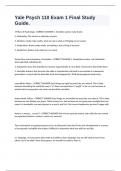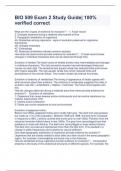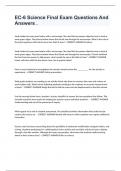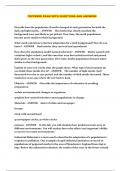Peppered exam - Study guides, Class notes & Summaries
Looking for the best study guides, study notes and summaries about Peppered exam? On this page you'll find 39 study documents about Peppered exam.
All 39 results
Sort by
PEPPERED EXAM WITH QUESTIONS AND ANSWERS...

-
Yale Psych 110 Exam 1 Final Study Guide.
- Exam (elaborations) • 27 pages • 2024
-
Available in package deal
-
- $11.99
- + learn more
Yale Psych 110 Exam 1 Final Study Guide. 5 Pillars of Psychology - CORRECT ANSWER 1. Evolution: genes make brains 2. Modularity: The mind is a collection of parts 3. Idealism: minds make reality, what we see is what is infringing on our senses 4. Materialism: Brains make minds, everything u see is firing of neurons 5. Empiricism: believe only what you can count Name three misconceptions of evolution - CORRECT ANSWER 1. Populations evolve, not individuals. Some ppl think individuals do....

-
Biology 1108 Unit 1 EXAM Questions and Answers 100% Pass
- Exam (elaborations) • 28 pages • 2024
-
- $12.49
- + learn more
Biology 1108 Unit 1 EXAM Questions and Answers 100% Pass The term "n" refers to the size of a population, that is, the number of individuals in that population. In general, in a sample of n individuals, the frequency of an allele is: A)the number of occurrences of the allele. B)the number of occurrences of the allele divided by n. C)the actual value of n D)the number of occurrences of the allele divided by twice the number of individuals in the sample (2n). E)twice the number of occur...

-
BIO 509 Exam 2 Study Guide| 100% verified correct
- Exam (elaborations) • 30 pages • 2023
-
- $9.49
- + learn more
BIO 509 Exam 2 Study Guide| 100% verified correct What are the 4 types of evidence for evolution? - 1. Fossil record 2. Changes observed during a relatively short period of time 3. Geographic distribution of organisms 4A. Similarities among organisms - signs of evolution preserved in organisms themselves 4B. Vestigial characters 4C. Embryology 4D. Molecular similarities indicate common ancestry How does the fossil record provide evidence for evolution? - A fossil record shows chang...

-
Biology 1108 Unit 1 EXAM Questions and Answers 100% Pass
- Exam (elaborations) • 28 pages • 2024
-
- $12.49
- + learn more
Biology 1108 Unit 1 EXAM Questions and Answers 100% Pass The term "n" refers to the size of a population, that is, the number of individuals in that population. In general, in a sample of n individuals, the frequency of an allele is: A)the number of occurrences of the allele. B)the number of occurrences of the allele divided by n. C)the actual value of n D)the number of occurrences of the allele divided by twice the number of individuals in the sample (2n). E)twice the number of occur...

-
Biology 1108 Final Exam Quiz Questions with 100% pass
- Exam (elaborations) • 15 pages • 2024
- Available in package deal
-
- $12.49
- + learn more
Biology 1108 Final Exam Quiz Questions with 100% pass The term "n" refers to the size of a population, that is, the number of individuals in that population. In general, in a sample of n individuals, the frequency of an allele is: - Correct Answer ️️ -the number of occurrences of the allele divided by twice the number of individuals in the sample (2n) If a population is not in Hardy-Weinberg equilibrium, we can conclude that: - Correct Answer ️️ -evolution has occurred because on...

-
Biology 1108 Unit 1 EXAM Questions and Answers 100% Pass
- Exam (elaborations) • 28 pages • 2024
- Available in package deal
-
- $13.49
- + learn more
Biology 1108 Unit 1 EXAM Questions and Answers 100% Pass The term "n" refers to the size of a population, that is, the number of individuals in that population. In general, in a sample of n individuals, the frequency of an allele is: A)the number of occurrences of the allele. B)the number of occurrences of the allele divided by n. C)the actual value of n D)the number of occurrences of the allele divided by twice the number of individuals in the sample (2n). E)twice the number of occur...

-
EC-6 Science Final Exam Questions And Answers .
- Exam (elaborations) • 31 pages • 2024
-
Available in package deal
-
- $12.29
- + learn more
EC-6 Science Final Exam Questions And Answers . Sarah looked at some pond water with a microscope. She used the low power objective lens to look at some green algae. The picture below shows that Sarah saw through the microscope. What is the role of the pond organisms that Sarah saw in her field of view? - CORRECT ANSWER Producer Sarah looked at some pond water with a microscope. She used the low power objective lens to look at some green algae. The picture below shows that Sarah saw thro...

-
HESI Biology Exam Questions And Answers 100% Verified
- Exam (elaborations) • 10 pages • 2024
- Available in package deal
-
- $11.49
- + learn more
HESI Biology Exam Questions And Answers 100% Verified What is the hierarchic system of organization in biology? - answerKingdom Phylum Class Order Family Genus Species What is considered the core theme in biology today? - answerEvolution Proposed by Darwin's "Origin of Species" What are the steps for an experiment to be performed? - answerHypothesis Experiment Gather Data Make a conclusion What is Specific Heat? - answerThe amount of heat necessary to raise the temperature of 1...

-
Solar System - Science Olympiad Exam Questions And Answers (Verified And Updated)
- Exam (elaborations) • 13 pages • 2024
- Available in package deal
-
- $12.49
- + learn more
Solar System - Science Olympiad Exam Questions And Answers (Verified And Updated) How did the terrestrial planets form? - answerIn the proto-Solar-Sytem, after the sun formed, the rest of the materials orbiting close around it began to clump together too. However, closer to the sun, lighter materials like gases blew away and only rocky material was left, causing the four terrestrial planets, and some of their moons, to form. What are the characteristics of Terrestrial Planets? - answerSol...

Study stress? For sellers on Stuvia, these are actually golden times. KA-CHING! Earn from your study resources too and start uploading now. Discover all about earning on Stuvia



